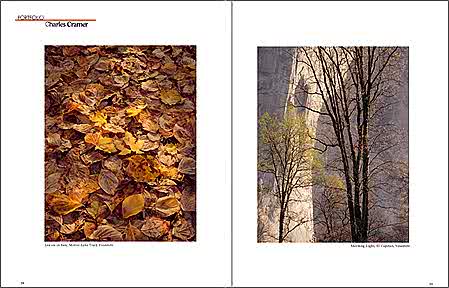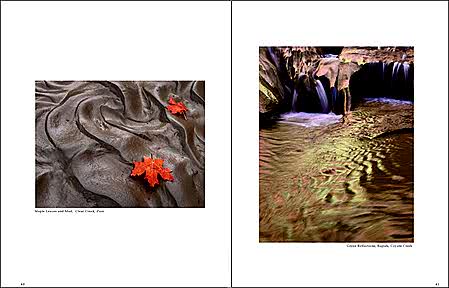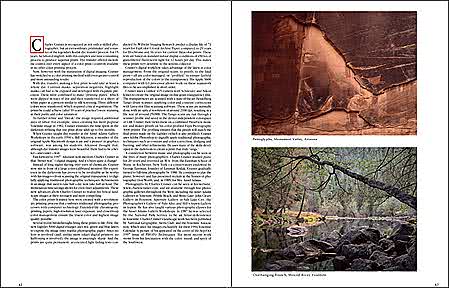from the January/February 2000 issue of PHOTO Techniques Magazine
Charles Cramer is recognized as not only a skilled photographer, but an extraordinary printmaker and a master of the legendary Kodak dye transfer process. For 15 years, he labored mightily with this complex and time-consuming process to produce superior prints. Dye transfer offered incredible control over every aspect of a color print; controls available in no other color printing process. Now, however, with the maturation of digital imaging, Cramer has switched to a color printing method with even greater control and more astounding results.
With dye transfer, making a first print would take at least a whole day. Contrast masks, separation negatives, highlight masks; all had to be exposed and developed with exquisite precision. These were combined to make printing plates, which were dipped in trays of dye and then transferred to a sheet of white paper in a process similar to silk-screening. Three different colors were transferred, which required critical registration. The prints he could achieve (after 10 years of practice!) were stunning in their purity and color saturation.
To further refine and tweak the image required additional days of labor. For example, since creating his most popular Yosemite image in 1982, Cramer estimates the time spent in the darkroom refining that one print alone adds up (over the years) to five months.
When Cramer taught dye transfer at the Ansel Adams Gallery Workshops in the early 1990's, Bill Atkinson, a member of the original Apple Macintosh design team and a pioneer in graphics software, was among his students. Atkinson thought that, although dye transfer images were beautiful, there had to be a better—and easier way. Fast-forward to 1997. Atkinson now mentors Charles Cramer in that better way: digital imaging. And it's been quite a change!
Instead of long nights slaving over trays of chemicals, Cramer now sits in front of a large color-calibrated monitor. His experience in the darkroom has proven to be invaluable as he works with his images—from scanning the original transparency to digitally applying traditional photographic techniques. Refinements in an image that used to take half a day now take half an hour. The tremendous time-savings allows for even finer adjustments. These new advances allow Charles Cramer to realize his lyrical landscape images at their strongest and most compelling.
The color prints featured here were created with a revolutionary printing process that combines traditional photographic processes with computer technology. Extended-life chromogenic printing papers, high-resolution laser exposure, and closed-loop color management ensure the truest color and highest image quality possible. Several recent breakthroughs bring these prints to life. First, the new LightJet 5000 digital enlarger uses red, green and blue lasers to expose the image onto regular photographic paper. Since no lens is involved (and, unlike most inkjet digital printers, no halftoning is involved), the image is amazingly sharp. And the prints are quite permanent: accelerated light fading tests conducted by Wilhelm Imaging Research predict a display life of 71 years for FujiColor Crystal Archive Paper, compared to 29 years for Ilfochrome and 16 years for current Ektacolor prints. These tests are based on standard indoor display conditions of 450 lux of glass-filtered fluorescent light for 12 hours per day. This makes these prints very desirable to the serious collector.
Cramer's digital workflow takes advantage of the latest in color management. From the original scans, to proofs, to the final print, all are color-managed, or profiled—to ensure faithful reproduction of the colors in the transparency. His Apple 9600 computer with G3 processor allows work on these mammoth files to be accomplished in short order.
Cramer uses a Linhof 4x5 camera with Schneider and Nikon lenses to create the original image on fine-grain transparency film. The transparencies are scanned with a state-of-the-art Heidelberg Tango drum scanner, applying color and contrast corrections with Linocolor Elite scanning software. These scans are normally done with an optical resolution of around 2100 dpi, resulting in a file size of around 250MB. The Tango scans are run through a scanner profile and saved in the device-independent colorspace of LAB. Cramer then views these on a calibrated PressView monitor, and makes proofs on his color-profiled Fujix Pictrography 3000 printer. The profiling ensures that the proofs will match the final prints made on the LightJet (which is also profiled). Cramer uses Adobe Photoshop to digitally apply traditional photographic techniques such as contrast and color correction, dodging and burning, and other refinements. He uses many of the skills developed in the darkroom to create a print that truly sings.
A connection between music and photography can be seen in the lives of many photographers. Charles Cramer studied piano for 20 years and received an M.A. from the Eastman School of Music in Rochester, New York—a conservatory endowed by George Eastman, founder of Eastman Kodak. Cramer gradually turned to full-time photography by 1980. He continues to play the piano, however, and has presented recitals at the homes of photographer Don Worth, and, in 1985, for Mrs. Ansel Adams.
Photographs by Charles Cramer can be seen at his website, www.charlescramer.com, and are available through fine photographic galleries throughout the West, including the Ansel Adams Galleries in Yosemite, Pebble Beach, and Mono lake; John Cleary Gallery in Houston; Aperture Gallery in Salt Lake City; the Photographer's Gallery of Palo Alto; and Hill's Aspen Gallery in Aspen. He has also taught various photography classes for the Ansel Adams Gallery Workshops. In 1987 he was selected by the National Park Service to be an Artist-in-Residence in Yosemite. Charles Cramer's landscape work has been published by National Geographic, Sierra Club, and the Yosemite Association, which used his images exclusively for their 1994 Yosemite Calendar. A picture of his appeared on the cover of the Sep/Oct 1997 issue of PHOTO Techniques. His most recent work stems from his fascination with the color, mood, and spirit of the Southwest.
The images used in PHOTO Techniques.



